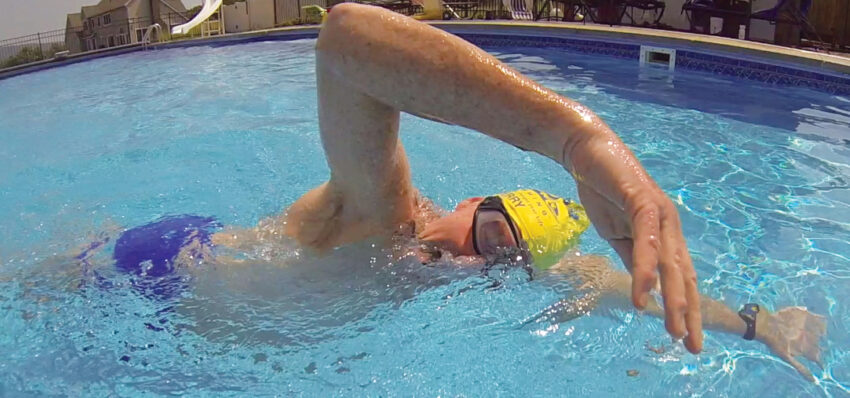
Three steps to seamless breathing
Fewer than 30 per cent of adults can swim 25 metres. And countless people who can run three to five hours continuously, during a marathon, become exhausted after as little as a minute of swimming – clearly not for lack of fitness. The reason for both is that breathing is such a complex and daunting skill.
But the ‘breathing barrier’ is as much psychological as skill-oriented. Breathing has panic-inducing potential for virtually all beginners because it exposes us to two primal fears: choking and sinking. Fear of choking causes us to lift or lunge as we breathe. This makes us more vulnerable to sinking… and thus more likely to choke.
Virtually all of us – even those who go on to complete marathon swims or win Olympic medals – experience these in our first attempts to swim, whether at age 6 or 46. The vulnerability we feel in our first strokes has such a powerful effect that latent fears deep in our subconscious cause inefficient breathing habits for decades after. The good news is that nearly everyone has the potential to breathe far more efficiently.
In experienced swimmers, while that moment of inefficiency passes in a fraction of a second, it’s repeated 30 times a minute. In a novice, it is often the main barrier to progressing from short repeats to a continuous mile. Mastering a few key skills will allow you to swim almost any distance with the ease of ‘conversational’ running. These skills fall into two categories: how to exchange fresh for stale air; and how to keep stroking efficiently as you do.
Get Fresh Air In
Simply getting air into and out of your lungs involves two unique complications:
• You face resistance from water pressure while exhaling.
• You exhale for much longer than you inhale, even more if you breathe bilaterally. This is quite similar to a singer holding a note, then taking a ‘bite’ of air between phrases.
Improve your air exchange with four focal points:
1. Push air out. Exhaling should be an intentional and energetic action. When you emphasise the exhale, the inhale happens as air rushes to ‘fill a vacuum.’
2. Keep it moving. Never hold your breath or interrupt air exchange. Breath-holding causes tension – and does little for buoyancy. Begin exhaling as soon as you finish inhaling. Indeed, your mouth should remain open at all times.
3. Finish strong. Exhale forcefully as your mouth reaches the surface, as if to blow the water away before inhaling.
4. Get just enough. Don’t try to completely fill – nor empty – your lungs. Get ‘just enough’ air. Breathe in swimming as you would while singing.
Maintain Stroke Efficiency
Rhythmic breathing in freestyle is the most exacting of all skills because you must fit the breath into an alternating-arm rhythm and nearly 8 per cent of your body mass (your head) is moving to the side, while the rest of you is moving forward.
Cut these challenges down to size by imprinting three habits:
1. Breathe with head and spine aligned: Don’t lift your head.
2. Breathe with body roll: Don’t turn your head.
3. Maintain a low-drag body position. Keep bodyline long and balanced – and lead arm positioned to hold the water – as you breathe.
Three Focal Points to Aid Seamless Breathing

1.Keep Head Aligned
This is not only a critical breathing skill, but the most fundamental aspect of efficient swimming! Develop awareness of this with short non-breathing repeats. Push off the bottom into a surface glide, then take six to eight strokes without breathing. Stand for a breather and mental reset. During the glide and while stroking, focus on one of the three listed exercises.
Repeat six or more times, or until you feel the sensation noted. Then swim longer repeats, adding just two to three breaths. Is the new sensation still present while breathing? Add more distance – and breaths – only as you can feel it while breathing.
1. Weightless: Let your head hang weightlessly between your shoulders as you stroke. Neck and upper back muscles should feel noticeably more relaxed. Does it still feel weightless as you rotate your head to the side?
2. Cushioned: Focus on feeling the density of water ‘cushion’ your face on non-breathing strokes – and the side of your head as you breathe.
3. Laser: Visualise your head-spine line as a ‘laser’ projecting forward on non-breathing strokes. Where does it point as you breathe?

2. Follow Your Shoulder
All body parts (arms, legs and head) should move as an integrated part of a whole-body action, synchronised with core body rhythms. Here’s how to do this when breathing to the left:
As your right hand enters the water and extends forward, your left shoulder rotates out of the water. To breathe, simply let your chin follow your shoulder. To breathe right follow the right shoulder. This integrates breath with body movement and minimises the chance of your head moving by itself.
Note: When swimming in rougher water, remember you will always find air at the tip of your shoulder. Instead of lifting your head or craning your neck for a breath, bring your chin slightly closer to the shoulder as you breathe.

3. Synchronise Breath Timing and Stroke Timing
You can also improve integration of breath and body action by synchronising breath timing with stroke timing. To do this, coordinate four key moments in your breath with what your hands are doing at that moment. For a right side breath, focus on the following:
1. Your left hand entering the water initiates rotation to the air.
2. Your face clears the water as your left hand reaches full extension.
3. Your left hand holds the water – and your place – as you inhale.
4. Your face submerges again as your right hand enters the water.
Should you breathe bilaterally?
As mentioned above, breathing in freestyle is such a frequent occasion for stroke errors because of the difficulty of keeping the body aligned, stable and traveling forward when 8 per cent of body mass repeatedly moves to the side. When we move that 8 per cent only to one side, thousands of times, errors caused by these uneven forces develop into deep-seated habits.
Bilateral breathing is guaranteed to improve symmetry in your stroke. (This will also help you swim a straighter course when not guided by lanes or lines.) And of course, comfort with breathing to either side is essential to adapting to the changing directions of waves or swells or the changing position of landmarks.
Strive to make your left and right sides feel equally consistent in the focal points outlined above. And remember that bilateral breathing isn’t limited to breathing every three strokes. Any number of breaths to the right, followed by the same number to the left, is just as good.






